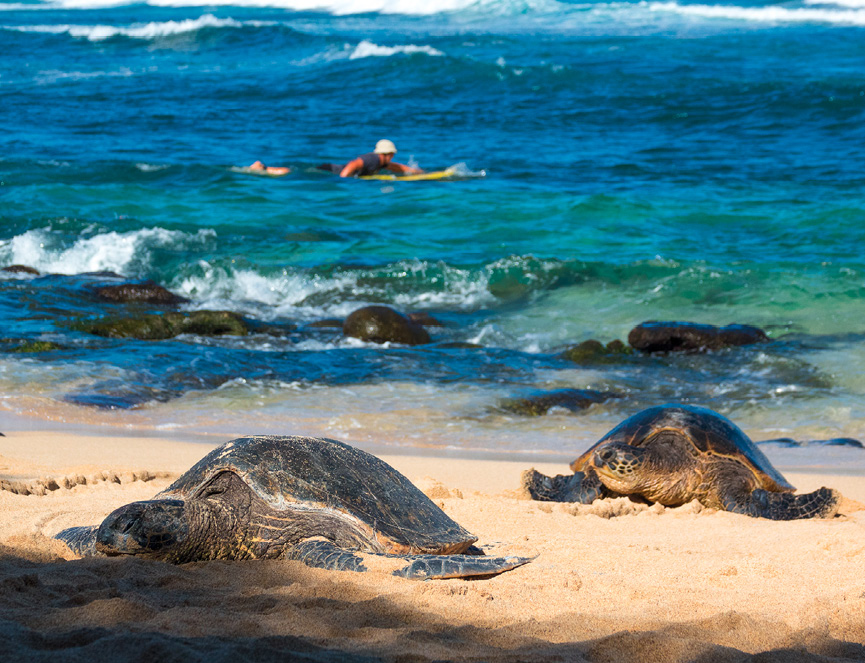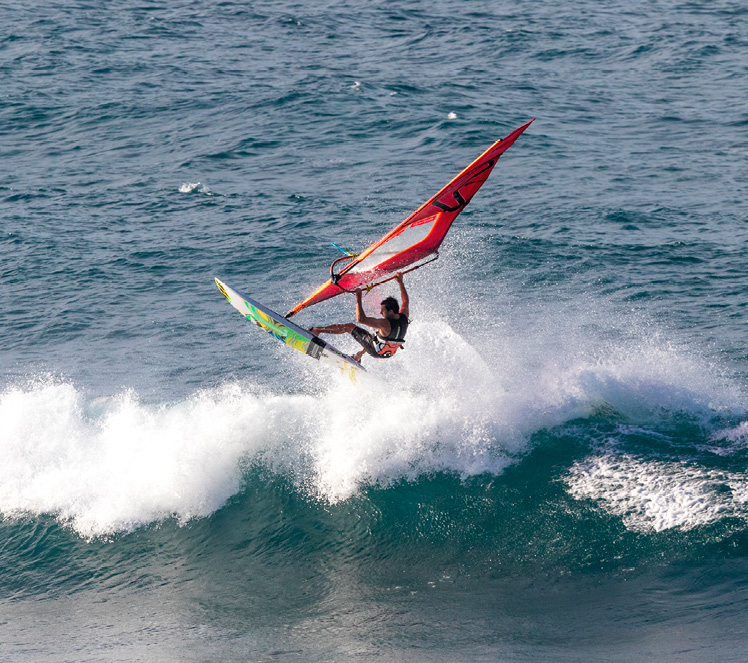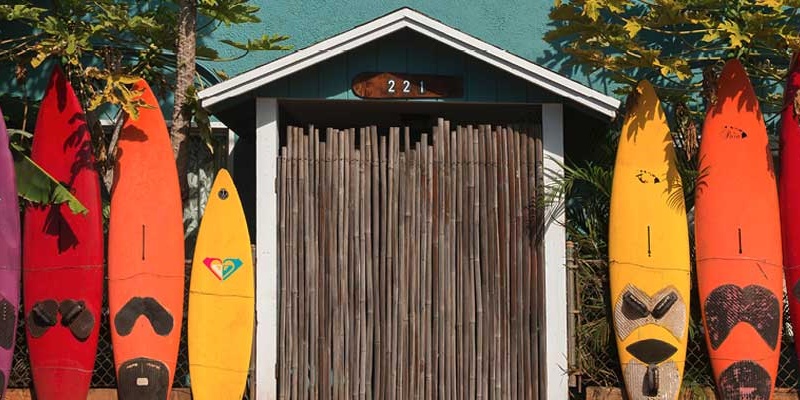By Cheryl Parton
When visitors to the Hawaiian Islands imagine the North Shore, they may visualize the long, barreling surf break of Oahu’s Banzai Pipeline. Yet there’s another North Shore found on Maui, where the city of Paia is no secret to lovers of its historic and bohemian vibe, beaches and world-class wind sports. Paia (prounounced pie-ee-uh) translates to “noisy” in native Hawaiian and the town meets the ocean where tradewinds bring waves crashing across the reefs off shore. They land on pristine beaches with an audible impact in a call that beckons visitors to enjoy Paia’s culture and island spirit.
Surf Town Vibe
Paia—divided into Lower Paia and Paia—is signified by a singular stop light at the T where Hana Highway meets Baldwin Avenue. To many, it is known only as the last stop before the Road to Hana begins. Yet historically, Paia was a center of Maui’s sugar cane economy and at one time was responsible for 20 percent of the island’s population—mostly immigrant mill workers from Japan, Korea, the Philippines and beyond. It boasted three movie theaters, a hospital and a population of 20,000.
Paia is a story of perseverance; a fire in the 1930s wiped the town out. Then, in 1946, the largest tsunami in the history of the islands hit Lower Paia. Not waiting for a third catastrophic event, many workers migrated to new communities of Kahalui and Wailuku and Paia settled into a quieter era, with the last sugar mill closing in 2000. Today, the easygoing vibe combines surf and upcountry ranching cultures. The colorful main street, with pastel-painted clapboard storefronts that evoke its plantation past, consists of art galleries, surf shops and an eclectic mix of secondhand vintage, designer clothing, bikini and souvenir stores.
Maui is called the Valley Isle, and the rich soil of its volcanic lands allows for robust farms. Green grocery Mana Foods on Paia’s main street, Baldwin Avenue, is the town’s social hub with its overflowing community bulletin board, and an array of natural foods and exotic fruits such as breadfruit, citrus, longan, mangosteen and rambutan in the winter. A reverence for the energetic spirit of the island shows up in the form of multiple yoga studios throughout town and Great Paia Lha Bab Peace Stupa landmark, consecrated by the 14th Dalai Lama in 2005, where visitors may walk around the 27-foot prayer wheel that is part of the monument. From the center of town, Baldwin Avenue heads straight toward the upcountry ranching town of Makawao. On the way, with bucolic views of open fields and the Maui isthmus toward the west, stop at the Hui No’eau Visual Arts Center for a look at exhibitions from local artists and those from around the world, or a tour of the historical 1917 Kaluanui Estate that gives a glimpse at Maui from a century ago.
Beautiful Beaches
Much of the native Hawaiian culture is reliant on its sacred relationship to nature—sea, sun and respect for ‘āina (land). The four-mile drive to Paia east along the Hana Highway from Kahului airport takes visitors parallel to the Pacific Ocean and provides multiple beaches worthy of a stop, to swim, or to experience the power of these elements. At Mile Marker 5, find Spreckelsville (home to the Maui Country Club), and enjoy Baby Beach, which is found at the west end of the shoreline. Here, the small, exposed reef creates a natural pool that is perfect for swimming laps or as a protected place for children to play. Three miles farther east, H.A. Baldwin Beach Park is a community center with its large parking area, bathrooms, showers and miles of open sand for walking or swimming. Traveling on, find picturesque Kuau Cove with idyllic white sand, bordered by swaying palm trees and tidepools at both ends. Here, at Mama’s Fish House, the menu provides not only a selection of fish caught the same day, but tells the story of each fisherman who reeled in the entrees served that evening.

Pacific green sea turtles bask in the sun along Maui’s northern shore. Photo courtesy of Susan Seubert.
Beaches of the North Shore provide respites not only for humans, but are frequented by Hawaiian green sea turtles, called honu in native Hawaiian, that use soft sand as resting spots from the aquatic life of feeding and living in the roiling waters offshore. At Ho’okipa Beach Park, the beached turtles—with their shells’ radius reaching up to two feet—resemble boulders from afar. Drag marks to and from the water are evidenced by sand designs mapping the turtles’ slow progress. Ho’okipa Beach Lookout, above the beach, is also an excellent vantage point from which to spot the migration of humpback whales that takes place from December through April. Watch for telltale signs of water spouts dotting the blue array of open ocean waters, especially as the sun begins to set across the horizon.
Windsurfing Capital of the World

Watch professional-level windsurfers from the vantage point of Ho’okipa Beach Lookout. Photo courtesy of Susan Seubert.
On Maui, there is a love affair with the wind. Given its position as the farthermost island to the north, Maui is the windiest of the Hawaiian Islands as dominant tradewinds come across the Pacific Ocean to land squarely on its central north shore. For many, whitecaps may be a signal to take cover, but for lovers of wind sports, it’s a cue to go out to windsurf, kiteboard, hydrofoil or wingfoil. Paia, specifically Ho’okipa, has been referred to as the Windsurfing Capital of the World, a moniker it earned in the 1970s when it was determined that conditions were near perfect for the sport here. At the height of windsurfing’s popularity, pioneers in sail, board and wave-riding such as Robby Naish, Mike Waltze and Pete Cabrinha set up shops in town. With access to world-class wind and waves at Ho’okipa, plus the discovery of what came to be known as Jaws—one of the largest surf breaks in the world—Maui’s North Shore soon created a buzz and destination appeal for not only athletes, but spectators of these sports that harness the power of the wind. Visitors have a front seat to wind sports from Ho’okipa Beach Lookout. Surfers have the water from sunrise to 11 a.m. each day, then wind athletes rig up and take to the sea with an array of sails, and kites for a colorful show against the blue surf break. For those inspired by the wind, there are plenty of schools ready to safely introduce beginners and more experienced riders to the range of wind sports. Paia imbues visitors in its island spirit whether watching from shore or engaging in play.
Let AAA Help You Plan Your Visit
Download the AAA Mobile app for maps, discounts, restaurants, and lodging at AAA.com/mobile. For help planning your trip, find a local AAA Travel Agent or call AAA Travel at 800-529-3222.


